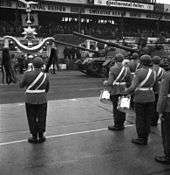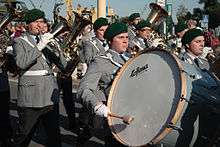Military bands of the Bundeswehr

There are 14 military bands of the Bundeswehr, including those of the German Army, Air Force, Navy, and joint bands. Before 2009, the military musicians of the Bundeswehr constituted a joint specialist service, the Military Music Service (German: Militärmusikdienst), subordinate to the Armed Forces Office (German: Streitkräfteamt). In 2009, as part of a larger reorganisation of the Bundeswehr, the organization of the Military Music Service was replaced by the new Military Music Center of the Bundeswehr (German: Zentrum Militärmusik der Bundeswehr) in Bonn, and several bands were disbanded. The bands of the Bundeswehr provide music for official ceremonies such as the Großer Zapfenstreich and the swearing-in of new recruits. In addition to their traditional military music repertoire, they perform concert band and light music, as well as genres such as jazz, rock, and pop.
Structure
The professional management of all the military bands of the Bundeswehr lies with the director of the Military Music Center of the Bundeswehr. Since 2001, Colonel Dr. Michael Schramm has held this position. The individual bands may be subject to military divisions or regional commands as well.
Joint bands
There are four joint service bands in the Bundeswehr that are part of the Armed Forces Office, a component of the Joint Support Service. There also are two bands associated with military districts, which used to be Army bands. Although these bands primarily use German Army uniforms, they are not officially subordinate to the Army.
| Insignia | Name | Location | Date established | Notes |
|---|---|---|---|---|
 | Staff Band of the Bundeswehr Stabsmusikkorps der Bundeswehr | Berlin | 1 April 1991 | Part of the Berlin Garrison Command, responsible for protocol in Berlin |
 | Bonn Band of the Bundeswehr Musikkorps der Bundeswehr | Siegburg | 16 February 1957 | Tours within Germany and internationally, and responsible for protocol in the Bonn area |
| Big Band of the Bundeswehr Big Band der Bundeswehr | Euskirchen | 29 March 1971 | Big band ensemble | |
 | Training Band of the Bundeswehr Ausbildungsmusikkorps der Bundeswehr | Hilden | 1999 | Responsible for training new musicians; planned to be moved to Düsseldorf |
 | Army Band Neubrandenburg Heeresmusikkorps Neubrandenburg | Neubrandenburg | 1 April 1991 | Established as Army Band 80, later Army Band 14, and Military District Band I |
 | Mountain Band of the Bundeswehr Gebirgsmusikkorps der Bundeswehr | Garmisch-Partenkirchen | 1 July 1956 | Established as the band of the 1st Mountain Division, now associated with Military District IV |
Army
| Insignia | Name | Location | Date established | Notes |
|---|---|---|---|---|
 | Army Band Hannover Heeresmusikkorps Hannover | Hannover | 1 July 1956 | Established as Musikkorps II A, later Army Band 1; associated with the 1st Panzer Division |
.jpg) | Army Band Kassel Heeresmusikkorps Kassel | Kassel | 1 July 1956 | Established as Musikkorps IV A, later Army Band 2 |
.jpg) | Army Band Koblenz Heeresmusikkorps Koblenz | Koblenz | 1 July 1956 | Established as Musikkorps IV B, later Army Band 300 |
 | Army Band Veitshöchheim Heeresmusikkorps Veitshöchheim | Veitshöchheim | 1 May 1962 | Formed as Air Force Band 5, later Army Band 13, and Army Band 12 |
.jpg) | Army Band Ulm Heeresmusikkorps Ulm | Ulm | 1 July 1956 | Established as Musikkorps V B, later Army Band 10 |
In addition to the professional Army bands, there are several amateur marching bands made up of reservists.
Air Force
| Insignia | Name | Location | Date established | Notes |
|---|---|---|---|---|
 | Air Force Band Münster Luftwaffenmusikkorps Münster | Münster | 11 July 1956 | Established as Air Force Band 1, later Air Force Band 3; in March 2014 the other three air force bands were merged with it |
| Air Force Band Erfurt Luftwaffenmusikkorps Erfurt | Erfurt | 15 March 1991 | Established as Army Band 70, later Military District Band III |
Navy
| Insignia | Name | Location | Date established | Notes |
|---|---|---|---|---|
 | Navy Band Kiel Marinemusikkorps Kiel | Kiel | 1956 | Previously Navy Band Baltic Sea, before it was merged with Navy Band North Sea in March 2014 |
History

While the formation of the Bundeswehr was being prepared in the 1950s, then-Chancellor Konrad Adenauer is said to have placed great importance on the formation of military bands. He demanded at least one band be formed during the Bundeswehr's first year of existence; and, indeed, six bands were formed. The first band of the Bundeswehr was established on 2 January 1956, Musikkorps III A in Andernach (later Army Band 7). The bands of the Bundewehr have gone through many phases of reduction, growth and change since then. For some time each Army division had its own band (some of these bands, like the Gebirgsmusikkorps, survive today in some form), and the Navy and Air Force have had more than their current one or two bands for most of their history. These serve as the link of the armed forces to the long years of the German military music tradition.
Personnel

The enlisted personnel of Bundeswehr bands are drawn from those who initially volunteer for two years of service in the Bundeswehr (and formerly conscripts). Unteroffiziere (junior NCOs) used to be allowed to enlist for a minimum of four years. Feldwebel (senior NCOs) enlist for a minimum of twelve years of service, including a four-year undergraduate degree in music at the Robert Schumann Hochschule. Commissioned officers earn a Diplom degree as Kapellmeisters and commit to a minimum of fifteen years of service. Senior NCOs and commissioned officers go through their advanced training as members of the Training Band of the Bundeswehr.
In the case of war, military musicians will serve in the Joint Medical Service. In addition to musical training, every musician receives some form of medical training, including study at the Medical Academy of the Bundeswehr (German: Sanitätsakademie der Bundeswehr) for senior personnel.
References
- "Militärmusikdienst der Bundeswehr in neuer Struktur" (in German). Blasmusik.de. 19 September 2009. Retrieved 8 August 2014.
- "Musik bei Bundeswehr, Bundespolizei, Polizei und Zivildienst". Musik-Almanach (in German). Regensburg: Deutscher Musikrat: 820–823. 2006.
External links
| Wikimedia Commons has media related to Military music of the Bundeswehr. |
- (in German) Official website